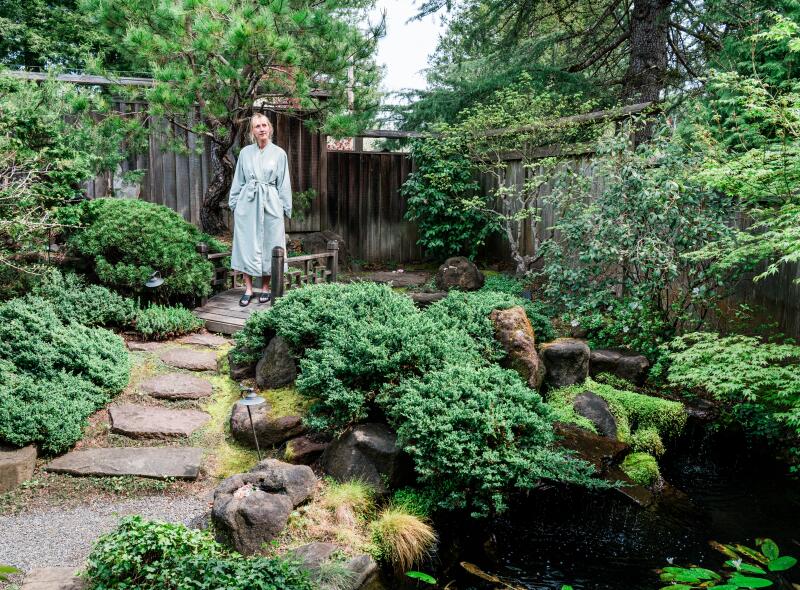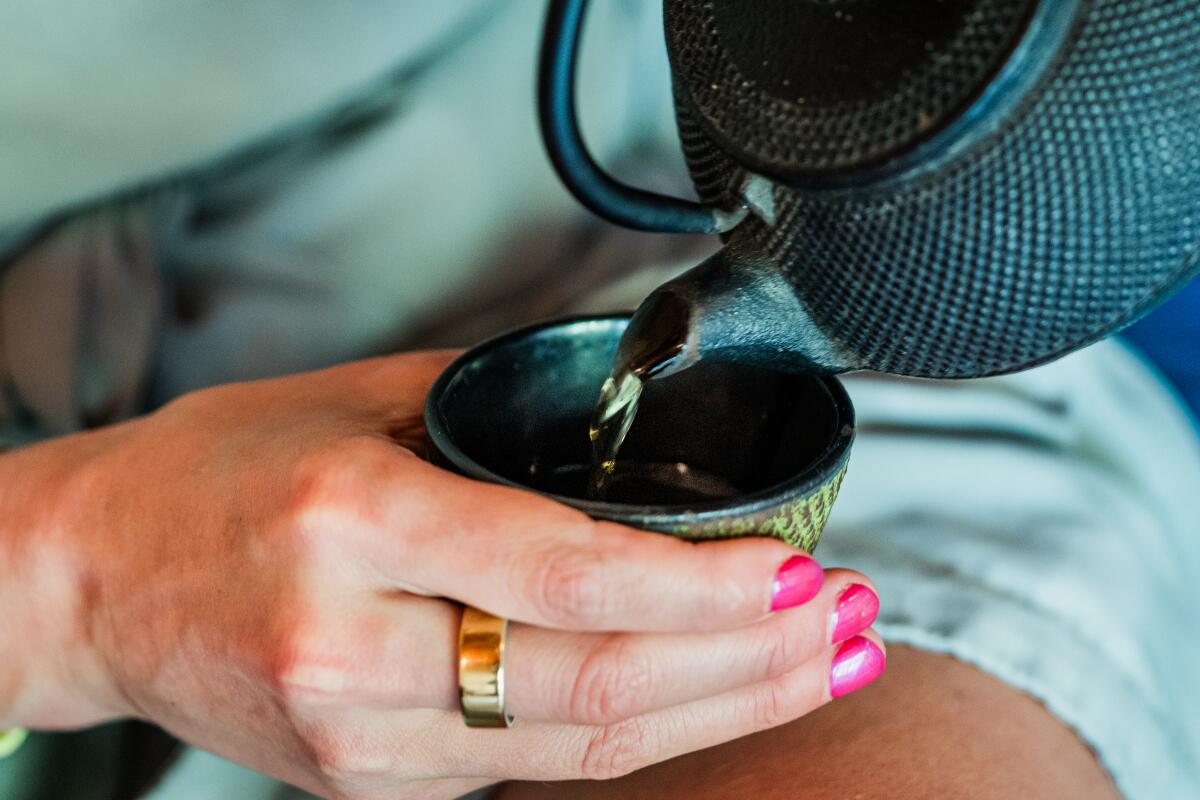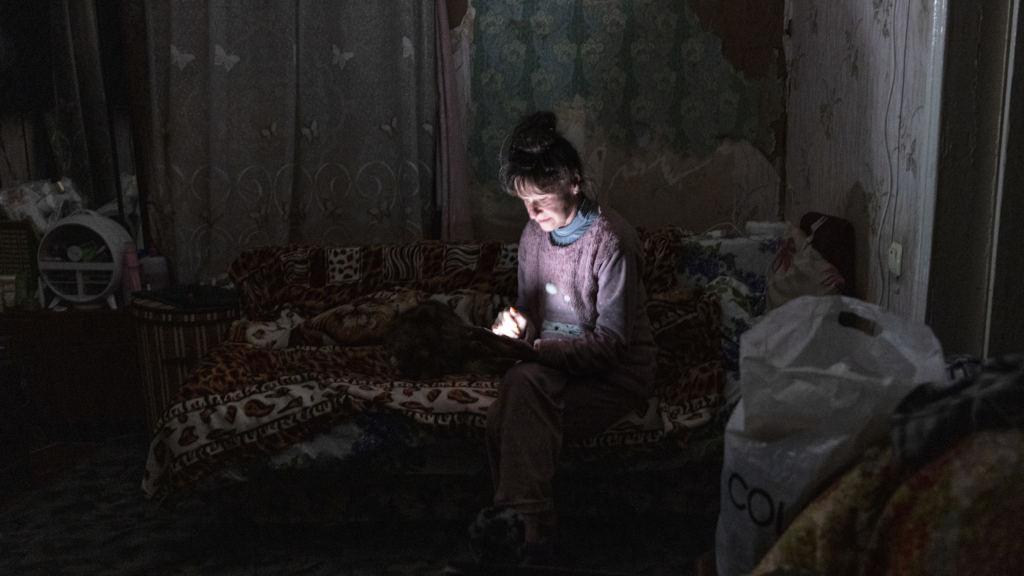Before our appointment at Osmosis Day Spa Sanctuary, a peaceful retreat off the Bodega Highway in West Sonoma county, a friend and I popped into a nearby gift shop. We told the owner that we were destined to try Osmosis’ storied treatment — a so-called “cedar enzyme bath” — and her eyes widened with excitement.
“You’ll feel like you’re a plant being composted,” she said, adding that the spa’s recycled bath materials lined the path of a neighboring garden.
When we were eventually led into Osmosis’ tidy changing rooms to disrobe, I smelled what she meant before I saw it. A dank, earthy odor hung in the air, as if mounds of fresh pencil shavings had been scattered over a newly excavated farm plot.


FREESTONE, CA — MARCH 29, 2025: A Koi pond at Kyoto-style Meditation Garden. Wellness Editor Alyssa Bereznak in an enzyme cedar bath at the Osmosis Day Spa in Freestone, California on Saturday, March 29, 2025. (Andri Tambunan / For The Times)
It’s the signature scent of a spa whose marquee treatment involves being blanketed up to your neck in a box of steaming compost. Known in Japan as an ion bath, it combines many spa treatments in one: a heated, weighted feeling to relax and soothe the body and a calming aromatherapy to pique the senses. Much like the mud baths of Calistoga, the experience is just as much about a novel brush with natural elements as it is an opportunity for release.
“I like to say that what’s going on in there is a fundamental impulse in biology,” Osmosis owner Michael Stusser said. “All these microorganisms get a chance to talk to each other. They all have infinite wisdom. They all communicate. So there’s this energy going on. There’s a whole flow.”
-
Share via
Stusser estimates that Osmosis has slung compost onto half a million guests in its 40 years of business. For much of that time, it was the only place in North America where you could consistently book a cedar enzyme bath, currently priced at $155 a person or $127.50 per person for a shared two-person vat. (In May 2023, Tahoe Forest Baths opened in Lake Tahoe and began offering them in partnership with the Japanese company Ohtaka Enzyme Co. Though Santa Monica’s Willow Spa once gave cedar enzyme baths, it has discontinued that service.) Now the creekside 5-acre spa is expanding its offerings, which include sound therapy sessions in zero-gravity loungers, meditation workshops and all-day retreats.

Healdsburg resident Simone Wilson and Wellness Editor Alyssa Bereznak in an enzyme cedar bath at Osmosis Day Spa. The warm, fragrant treatment originated in Japan.
(Andri Tambunan / For The Times)
The smell that permeates Osmosis’ halls is the byproduct of a very intentional process, said Stusser. The enzyme bath concoction is a mix of fragrant Douglas fir and Port Orford cedar (a tree that the native Karok people of northwest California once used to construct sweat lodges) and rice bran, which activates the composting process.
“There’s literally billions of organisms in there feeding on nitrogen and generating heat with their bodies, breaking down carbon,” Stusser said. “That’s what they do.”
The spa’s staff is responsible for keeping the mixture from becoming hygienically dubious both by replacing it and churning it multiple times a day, thus ensuring there’s enough oxygen to keep that activity moving. We observed the process before our personal meeting with the mulch. Our spa attendant for the day, Samundra Sutcliffe, lodged a large pitchfork into the vat shavings and turned it over on top of itself as steam emanated from the pile.

Attendant Samundra Sutcliffe churns the cedar enzyme shavings at Osmosis Day Spa Sanctuary.
(Andri Tambunan / For The Times)
“If it doesn’t get fluffed enough, the material starts to compact and it starts to break down, what’s called anaerobically, which is without oxygen,” said the spa’s general manager, Heather Bishop. “Sometimes we’ll end up with less appealing smells.”
Stusser, 78, has a deep education in biodynamic gardening. He studied Agroecology at University of Santa Cruz under organic gardening and farming pioneer Alan Chadwick, who founded the school’s “French-intensive” garden in 1967. (Stusser went on to film a 1971 documentary, “The Garden,” about the project.) As Stusser got more into the bio-intensive gardening scene, he became enamored with compost.
“I saw the alchemical power of compost to transform not only the soil, but everything that was put into it,” he said. “And I had a secret wish that I never was willing to admit to anyone, which was to be buried in a compost pile.”

Osmosis serves a special enzyme-infused tea before guiding guests to its signature cedar enzyme bath.
(Andri Tambunan / For The Times)
After living on and tending to the land at the Farallones Institute Rural Center (now the Occidental Arts & Ecology Center in Sonoma County), Stusser traveled to Japan in 1981 to become a landscape gardening apprentice. The program, a seven-days-a-week dawn-til-dusk grind, proved to be far too intense, so he quit and went to live in a Zen temple in Obama-shi. There Stusser developed a serious case of sciatica and went on a quest to heal himself. He ended up on the island of Kyushu, where he stumbled upon an enzyme bath center where people of different ages and ailments had come to heal.
“As soon as I saw what was happening, I realized this is actually the same dynamic that exists in compost,” Stusser said. “I said, I’m going to finally get my wish.”
A farmer in southwestern Hokkaido named Noboru Ohtaka came up with the idea for a so-called “ion bath” after stepping on a sawdust enzyme fertilizer he’d developed and noticing it felt pleasant. His company, Ohtaka Enzyme Co. opened its first ion house in Sapporo City in 1964, said company President Seiichi Imai. Seven years later, when the city hosted the Winter Olympics, organizers built enzyme baths for athletes to use in the Olympic village.
“As the facility was continuously featured in newspapers and on television, the concept of the enzyme bath spread across Japan,” Imai shared in an email.
The enzyme bath Stusser tried was consistent with the original practice. It involved undergoing the treatment two times a day for a week, during which he fasted save for an enzyme drink, and received ashiatsu massages (in which a practitioner walks on your back). He said the treatment resolved his sciatica. He also had a spiritual experience.
“I was in the enzyme bath and as part of that experience, like in a millisecond of this vast experience, I saw the whole creation of Osmosis unfold before my mind’s eye in an instant, crystal clear, undeniable, and I knew it was my calling to do this,” he said.
He returned to the U.S. and got to work. On May 21, 1985, he opened Osmosis. At first, he said, it was hard to persuade people to live out the same wish of being composted that he’d held for so many years.
“I could barely give it away in the beginning,” he said. “But once they did it and discovered how much better it made them feel, we have had a lot of people coming for decades.”
As my friend and I sat robe-clad in a tea room staring out at a glass door that opened to a private Zen garden and sipping a hot enzyme herbal tonic with yarrow, red clover and peppermint, I contemplated my imminent encounter with the compost. I’m an avid gardener who has dusted my plants with compost and brewed her own kombucha. But even I felt a trickle of hesitation at being smothered in a bacteria-laden mulch.
Before I could give it a second thought, our attendant, Samundra, led us into a separate room with what looked like an adult sandbox. Two human-sized seats had been carved into the enzyme cedar mix to ensure we had sufficient support as we gazed out onto another private zen garden. We were left alone briefly to settle in and cover ourselves in the mix. When she reentered, she began shoveling it on to both of us until only our heads were visible.
“If you do get too hot, you can always pull out your arms, and I’ll just be coming out to check on you,” she said.
Up close and personal, the musk of the odor dissipated, and I breathed in the grounding spice of the cedar and the energizing citrus notes of the Douglas fir. It felt as though my body was wrapped in a hot compress. I tend to overheat easily in jacuzzis and hot springs but the enzyme bath felt breathable. (I later learned that this is because wood has a lower thermal conductivity than water, and the cedar enzyme mix allows for more aeration.)
As my friend and I began to sweat, Samundra arrived with cold compresses and draped them across our necks. With our arms still buried under the compost, she brought ice-cold waters with straws up to our mouths so we could hydrate — a truly luxurious part of the service.
The allotted 20 minutes went quickly. And when our time was up, she dug us out enough for us to break free. We used special grated mittens to wipe the mixture off of our bodies in the private zen garden, then rinsed off in the shower. My body was warmed from within, my typically tight-and-achy lower back and shoulders, slack and painless. After a trip to a spa I can sometimes feel like I’m on the verge of a nap, but in this case I felt invigorated and present, ready to tour the gardens that awaited outside.
When I later relayed my journey of skepticism to convert to Stusser, he said it was a common one.
“You can’t really explain it to somebody until you’ve done it,” Stusser said. “A lot of people will be very inquisitive on the phone. They go, ‘Well, can you tell me something more about what is it really doing?’ Then they get here and they look at it, and they’re not even sure they want to go in. And then they get in and get a big smile. ‘Oh, this is what it is like.’”
It was true. I had been composted like a plant — and I liked it.


